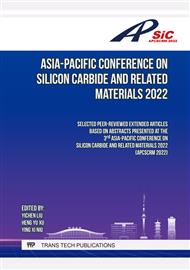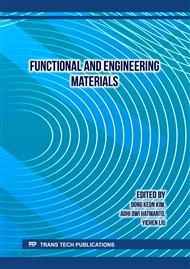[1]
T. Kimoto, Material science and device physics in SiC technology for high-voltage power devices, Jpn. J. Appl. Phys. 54(4) (2015) 040103.
DOI: 10.7567/jjap.54.040103
Google Scholar
[2]
Z. Zhang, Z. Wang, Y. Guo, J. Robertson, Carbon cluster formation and mobility degradation in 4H-SiC MOSFETs, Appl. Phys. Lett. 118(3) (2021) 031601.
DOI: 10.1063/5.0037241
Google Scholar
[3]
X.Y. Huang, G.F. Jiao, W. Cao, D. Huang, H.Y. Yu, Z.X. Chen, N. Singh, G.Q. Lo, D.L. Kwong, L. Ming-Fu, Effect of Interface Traps and Oxide Charge on Drain Current Degradation in Tunneling Field-Effect Transistors, IEEE Electron Dev. Lett. 31(8) (2010) 779-781.
DOI: 10.1109/led.2010.2050456
Google Scholar
[4]
T. Kimoto, H. Watanabe, Defect engineering in SiC technology for high-voltage power devices, Appl. Phys. Express 13(12) (2020) 120101.
DOI: 10.35848/1882-0786/abc787
Google Scholar
[5]
K. McDonald, R.A. Weller, S.T. Pantelides, L.C. Feldman, G.Y. Chung, C.C. Tin, J.R. Williams, Characterization and modeling of the nitrogen passivation of interface traps in SiO2/4H–SiC, J. Appl. Phys. 93(5) (2003) 2719-2722.
DOI: 10.1063/1.1542935
Google Scholar
[6]
S. Wang, S. Dhar, S.R. Wang, A.C. Ahyi, A. Franceschetti, J.R. Williams, L.C. Feldman, S.T. Pantelides, Bonding at the SiC- SiO2 interface and the effects of nitrogen and hydrogen, Phys. Rev. Lett. 98(2) (2007) 026101.
DOI: 10.1103/physrevlett.98.026101
Google Scholar
[7]
H. Yoshioka, T. Nakamura, T. Kimoto, Generation of very fast states by nitridation of the SiO2/SiC interface, J. Appl. Phys. 112(2) (2012) 024520.
DOI: 10.1063/1.4740068
Google Scholar
[8]
S. Nakazawa, T. Okuda, J. Suda, T. Nakamura, T. Kimoto, Interface Properties of 4H-SiC (112 ̅0) and (11 ̅00) MOS Structures Annealed in NO, IEEE Trans. Electron Dev. 62(2) (2015) 309-315.
DOI: 10.1109/ted.2014.2352117
Google Scholar
[9]
Y. Wang, Z. Peng, H. Shen, C. Li, J. Wu, Y. Tang, Y. Zhao, X. Chen, K. Liu, X. Liu, Characterization of the effects of nitrogen and hydrogen passivation on SiO2/4H-SiC interface by low temperature conductance measurements, J. Semicond. 37(2) (2016) 026001.
DOI: 10.1088/1674-4926/37/2/026001
Google Scholar
[10]
B. Yu, Y. Yuan, H.P. Chen, J. Ahn, P.C. McIntyre, Y. Taur, Effect and extraction of series resistance in Al2O3-InGaAs MOS with bulk-oxide trap, Electron. Lett. 49(7) (2013) 492-493.
DOI: 10.1049/el.2013.0433
Google Scholar
[11]
H. Yoshioka, T. Nakamura, T. Kimoto, Accurate evaluation of interface state density in SiC metal-oxide-semiconductor structures using surface potential based on depletion capacitance, J. Appl. Phys. 111(1) (2012) 014502.
DOI: 10.1063/1.3673572
Google Scholar
[12]
J.J.A. Cooper, Advances in SiC MOS Technology, Phys. Status Solidi. A 162(1) (1997) 305-320.
Google Scholar
[13]
B. Liu, F. Qin, D. Wang, Passivation of SiO2/4H–SiC interface defects via electron cyclotron resonance hydrogen–nitrogen mixed plasma pretreatment for SiC surface combined with post-oxidation annealing, Appl. Surf. Sci. 364 (2016) 769-774.
DOI: 10.1016/j.apsusc.2015.12.226
Google Scholar



